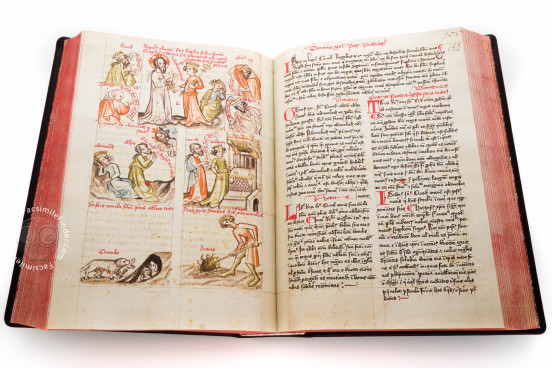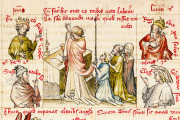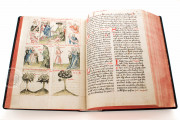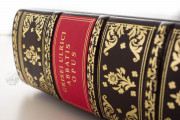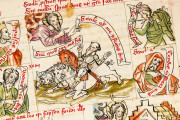The Budapest Concordance of Charity, copied in 1413 in Vienna by Stephanus Lang, stands as the most richly illuminated and complete surviving version of the Concordantiae caritatis by Ulrich von Lilienfeld. The manuscript contains 245 typological miniatures executed by seven artists in styles betraying eclectic influences. Its picture-text format presents a complex interplay of theological, biblical, natural, and moral themes. The manuscript served as a pedagogical tool of historical, theological, artistic, and cultural importance. It concludes with a catechism that portrays virtues and vices through vivid illustrations, reinforcing its didactic intent.
This manuscript exemplifies typological structure, where events from the Old and New Testament are arranged according to their role in the story of Redemption.
The Author and the Work
The Concordance of Charity preserved in Budapest is the work of Ulrich von Lilienfeld, who served as the Cistercian abbot of Lilienfeld Monastery in Lower Austria between 1345 and 1351.
Old Testament scenes serve as prototypes for New Testament events, which represent their ultimate fulfillment, together forming a unified and mutually illuminating whole.
Uniqueness and Structure of the Work
The Concordantiae caritatis stands as the most comprehensive typological collection of the Middle Ages, comprising 238 typological units with encyclopedic intention. Its extraordinary nature lies not only in its scope but also in its content innovation: natural phenomena and scenes from saints' lives were integrated into the typological system, serving as moral examples alongside Christ's life. Each typological unit occupies two facing pages—text on the right, illustrations on the left—with five components: a central main scene at the top, two Old Testament prototypes below, and two natural parallels at the bottom.
The work concludes with a "picture-catechism" partly in German, featuring virtues and vices as protagonists battling on animal mounts, assisting the Knight of Christ, or driving chariots to heaven or hell.
Central European Significance
The Concordantiae caritatis is distinctly Central European, both in authorship and distribution. All surviving copies are manuscripts, predominantly originating from Southern Germany and Austria, with many still housed in German and Austrian libraries.
Though intended as an illustrated volume for educational and preaching purposes, contemporary users primarily employed it for sermon preparation. Of only eight known illustrated copies, the Budapest manuscript holds distinguished status due to its exceptional quality and completeness.
The Budapest Manuscript's Content
The Budapest manuscript encompasses 1,225 scenes and natural phenomena across 262 folios, each accompanied by colored pen-and-ink drawings. These illustrations bring to life biblical events, legends, and both mythical and real animals within settings that preserve numerous details of medieval material culture. The technical characteristics of these drawings create an immediate visual impact, preserving the moment of creation for modern viewers.
The manuscript serves not only as an inexhaustible repository of representations of the natural and supernatural world, but also as a historical artifact in its own right.
Creation and Authorship
According to the colophon, Stephanus Lang, a Viennese burgher, wrote the text in 1413 in his own home. Lang was an educated individual who earned a baccalaureus in artibus from Prague University before establishing a family in Vienna and holding various municipal positions, including notary, Kirchmeister of Stephansdom, and city alderman. His deep faith is evidenced by his Memento mori meditation on death (circulated as Memoria improvisae mortis) and his 1419 will, which details his family and wealth.
Artistic Significance
Seven artists of varying skill levels collaborated on the Budapest manuscript's illustrations, with the most talented associated with the circle of the Master of the Sankt Lambrecht Votive Picture—a dominant stylistic group in early fifteenth-century Viennese panel painting. While we cannot definitively attribute other works to these artists, their contribution to the Budapest Concordantiae caritatis enriches our understanding of Viennese art circa 1400 with more than 1,000 illustrations.
The stylistic diversity among these masters illuminates Vienna's cultural variety, while their collaborative relationships offer insights into late medieval workshop practices and artistic cooperation.
Hungarian Provenance
The Budapest Concordantiae caritatis has been part of Hungarian book history since the seventeenth century. Its documented provenance includes ownership by Pál Lászlóffy in 1646 (possibly acquired in Vienna), the Pálffy family at Bajmóc Castle (now Bojnice, Slovakia) in 1666, and the Piarist Order's library in Pozsonyszentgyörgy (now Svätý Jur, Slovakia) in 1795, where it received its gilded leather binding. In 1906, it entered the Central Library of the Piarist Order in Budapest.
First published by Piarist monk László Papp in 1979, the manuscript quickly garnered attention from Hungarian and international researchers, though comprehensive analysis remained to be undertaken.
We have 1 facsimile edition of the manuscript "Budapest Concordance of Charity": Budapester Concordantiae Caritatis facsimile edition, published by Schöck ArtPrint Kft., 2011
Request Info / Price
